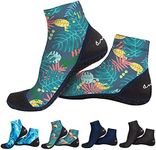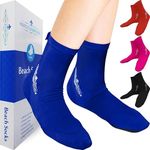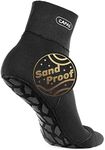Buying Guide for the Best Beach Volleyball Socks
Choosing the right beach volleyball socks can make a big difference in your comfort and performance on the sand. While it might seem like a simple purchase, the right pair of socks can protect your feet from hot sand, blisters, and abrasions, while also providing grip and breathability. To find the best fit for you, it's important to understand the key features that set different socks apart and how these features relate to your personal needs and playing style.MaterialThe material of beach volleyball socks is crucial because it affects comfort, durability, and how well the socks protect your feet from heat and sand. Common materials include neoprene, polyester blends, and spandex. Neoprene offers excellent protection from hot sand and abrasions, making it ideal for intense play or very hot conditions. Polyester blends are lighter and more breathable, suitable for moderate temperatures and those who prioritize comfort over maximum protection. Spandex adds stretch, ensuring a snug fit. To choose the right material, consider how hot the sand gets where you play and whether you need more protection or more breathability.
ThicknessThickness determines how much cushioning and protection the socks provide. Thicker socks offer better insulation from hot sand and more padding against rough surfaces, but they may feel warmer and less flexible. Thinner socks are lighter and allow for more natural movement, but may not protect as well from heat or sharp objects. If you play in very hot or rough conditions, thicker socks are a good choice. For cooler weather or if you prefer a barefoot feel, thinner socks may be better.
Grip and Sole DesignThe grip or sole design of beach volleyball socks helps prevent slipping on sand and provides stability during quick movements. Some socks have textured or rubberized soles for extra traction, while others are smooth for a more natural feel. If you value stability and play competitively, look for socks with enhanced grip. If you prefer a minimalist experience or play casually, a simpler sole may suffice.
Fit and SizingA proper fit is essential for comfort and performance. Socks that are too loose can bunch up and cause blisters, while socks that are too tight may restrict movement or circulation. Most brands offer a range of sizes, and some socks have adjustable straps or elastic cuffs for a secure fit. To pick the right size, measure your foot and consult sizing charts, and consider whether you prefer a snug or relaxed fit based on your activity level and comfort preferences.
Breathability and Drying SpeedBreathability and drying speed are important for keeping your feet cool and comfortable, especially during long games or in hot weather. Socks with mesh panels or moisture-wicking materials help sweat evaporate and prevent overheating. Fast-drying socks are also useful if you play in wet conditions or want to wash and reuse them quickly. If you tend to sweat a lot or play in humid environments, prioritize socks with good ventilation and quick-drying properties.
Protection FeaturesSome beach volleyball socks offer extra protection features like reinforced toes, padded heels, or UV protection. Reinforced areas help prevent wear and tear, while padding can reduce the risk of blisters and bruises. UV protection is useful if you play in strong sunlight and want to shield your skin. If you play frequently or in challenging conditions, look for socks with these added features to extend their lifespan and protect your feet.



![Beach Socks [2 Pairs] Wear in Sand](https://images-proxy.bestreviews.guide/NciCcYbTandLgf2969PiYziP75w=/0x150/https://m.media-amazon.com/images/I/414TLh0MzDL._AC_CX679_.jpg)










